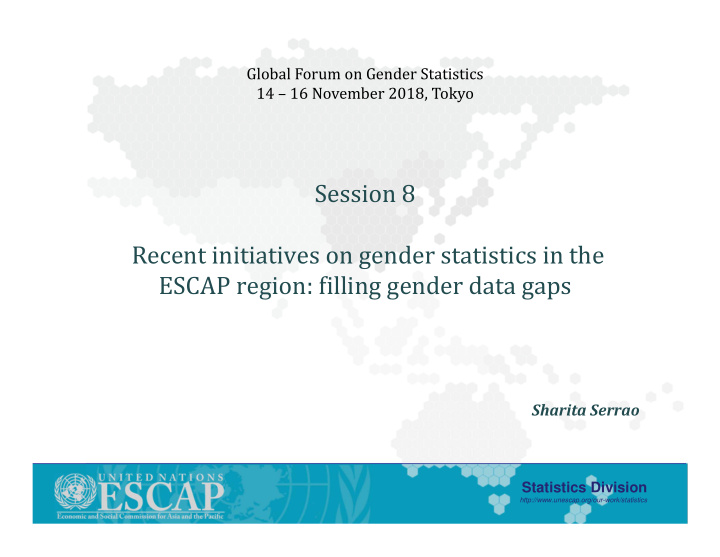



Global Forum on Gender Statistics 14 – 16 November 2018, Tokyo Session 8 Recent initiatives on gender statistics in the ESCAP region: filling gender data gaps Sharita Serrao Statistics Division http://www.unescap.org/our-work/statistics
Initiatives of the Committee on Statistics (CST): integration of gender perspective Major regional initiatives: Population and social statistics (PSS); Economic statistics, Disaster-related statistics, CRVS Gender integration in PSS in Asia and the Pacific: Core Set of PSS indicators (CST 3, 2012) Regional Strategy to improve PSS (CST 4, 2015) Implementation plan for Regional Strategy (CST 5, 2016) Regional Steering Group (RSG) on PSS ( Aug 2017) Work plan to achieve three goals: (1)Enabling environment to create/sustain data demand (2)Improving data availability (3)Improving data accessibility/use Statistics Division 2 http://www.unescap.org/our-work/statistics
ESCAP Gender Policy-Data Integration Initiative (GPDI): strengthen data and statistics for GEEW Goal 1: Engagement of NSOs with policy counterparts Enabling policy environment Key GEEW statistical information/disaggregated data to create/ sustain demand needs (policy-data integration) GEEW monitoring/indicator frameworks Enhance Capacity of NSS Goal 2: Existing statistical methodology/standards Availability and quality of Innovative approaches for disaggregated data disaggregated statistics (statistical production) Goal 3: Existing data for progress monitoring, analysis and policy Data accessibility, analysis, advocacy interpretation and use (accessibility and use) Statistics Division 3 http://www.unescap.org/our-work/statistics
GPDI: Phase I Phase I (2018-2019): focus on Goal 1 and Goal 3 Substantive focus: women’s economic empowerment (WEE) SDGs (1-5, 8, 10…) CSW61; UNSG High-level Panel on Women’s Economic Empowerment; Country needs assessments (2010 – 2016) Methodological development: Unpaid work, women’s asset ownership, entrepreneurship, informal sector, VAW… Regional inception workshop, April 2018, Bangkok: Armenia, Philippines Sri Lanka and Thailand (members of RSG-PSS) National workshops: National data users and producers Philippines (Aug 2018, PSA, PCW, NEDA, other NGAs) Armenia and Thailand (expected 2019), Sri Lanka (TBC) Statistics Division 4 http://www.unescap.org/our-work/statistics
GPDI Phase I: Tools and national outputs WEE policy content Comprehensive national I analysis • Goal 1 Generic Policy-Data indicator set on WEE (policy-data Integration Tool Recommendations for WEE • integration) (EPIC) policy (re)formulation Steps, considerations, Template/guidelines II Data-driven/analytical approaches for progress product on WEE: Goal 3 assessment / Use of existing data (data accessibility • gender analysis Awareness raising/policy and use) • (on selected WEE advocacy issues) Statistics Division 5 http://www.unescap.org/our-work/statistics
GPDI Goal 1: Generic policy-data integration tool [EPIC- Every policy is connected]: Rationale User-producer engagement to address vicious cycle of policy and data Inadequate demand for data Existing national Existing national development/ development/ sector plans sector plans lack supporting Lack of data; not specific Lack of demand for data; national enough about Non-specific policies; monitoring/ population Lack of evidence indicator groups & frameworks issues for specifying target disaggregated intervention Insufficient comprehensive and data needs high quality statistics Hampers political, institutional and financial support required to enhance data availability Statistics Division 6 http://www.unescap.org/our-work/statistics
EPIC steps: pathway to… (i) comprehensive national indicator set on WEE & (ii) re(formulation) of sector plans, NDP, NSDS.. Identify issues for action (IA) IA and TGs reflected in the national policy priorities • and IA and TGs not currently reflected in the policy • target groups priorities are identified (TG) • Derived from Social, Economic, Environmental and Institutional principles embedded in international Map to core conventions concepts • Core concepts mapped against IA reflected in the national policy priorities Map/align • Map IA and characteristics of the TGs to national, regional, national/regional/global indicators global indicators • Align national indicators with related to WEE regional/global indicators Statistics Division 7 http://www.unescap.org/our-work/statistics
EPIC: some key highlights 1. Integration across social, economic, environment & institutional (development) pillars 2. Intersecting forms of inequalities/discrimination & disaggregated data needs 3. Indicators responsive to policy needs + comprehensive “one-stop- shop” for WEE indicators 4. Systematic purpose driven user-producer engagement & “whole-of- government” approach for WEE 5. Policy/data gaps, waste, void Statistics Division 8 http://www.unescap.org/our-work/statistics
Conceptualization & GPDI Operational Planning Application Goal 3 Progress Assessment Stock-take priority WEE issues • Results of Results of Issues for report & Why? • EPIC EPIC Linking to goals/ pre-existing • targets; new targets Objectives & motivation • Relevant indicators & disaggregation Target audience, users and • • Data sources uses • Methods to track progress --------------------- • Stakeholders to be • consulted/involved Timeline • Gender-based Analysis Modality for • Further inquiry based on rate of (or consultation/coordination/ • lack of) progress drafting of report Conceptual framework: Solutions for data and • • drivers/influencing factors institutional challenges Hypothesis & research questions • Explanatory variables • Statistical analysis methods • Visualization (charts and tables) • Conclusions & policy Statistics Division recommendations 9 http://www.unescap.org/our-work/statistics
GPDI Goal 3: Time-use data analysis manual Compilation of a set of papers by academicians/researchers Demonstrate application/ potential of TUS data for GEEW policy analysis and guide use of such data for related SDG monitoring and analysis Self-training of individuals with appropriate background & guide design of related training workshops Two parts: I. Methods and techniques for collecting, storing, processing and analyzing time-use data (e.g. modalities of data collection, handling simultaneous activities, episode occurrences and sequencing etc.) II. Time-use data applications addressing key policy issues and development concerns, with country examples and hand-on exercises using data from national surveys (e.g. using TUS data to analyse informal employment / unpaid work/ LFP; household division of labor and time allocation; time poverty; impacts of public investments in basic infrastructure on time-use etc.) Existing data from TUS: Australia, China, India, Mongolia, Turkey, USA Statistics Division 10 http://www.unescap.org/our-work/statistics
Resources: GPDI: https://www.unescap.org/sites/default/files/ESCAP.CST_.201 8.INF_.2_Transformation_gender_data.pdf https://www.unescap.org/blog/progressing-women- economic-empowerment EPIC: https://www.unescap.org/sites/default/files/ESCAP.CST_.201 8.CRP_.1_EPIC_a_generic_tool_for_policy-data_integration.pdf Statistics Division 11 http://www.unescap.org/our-work/statistics
Recommend
More recommend